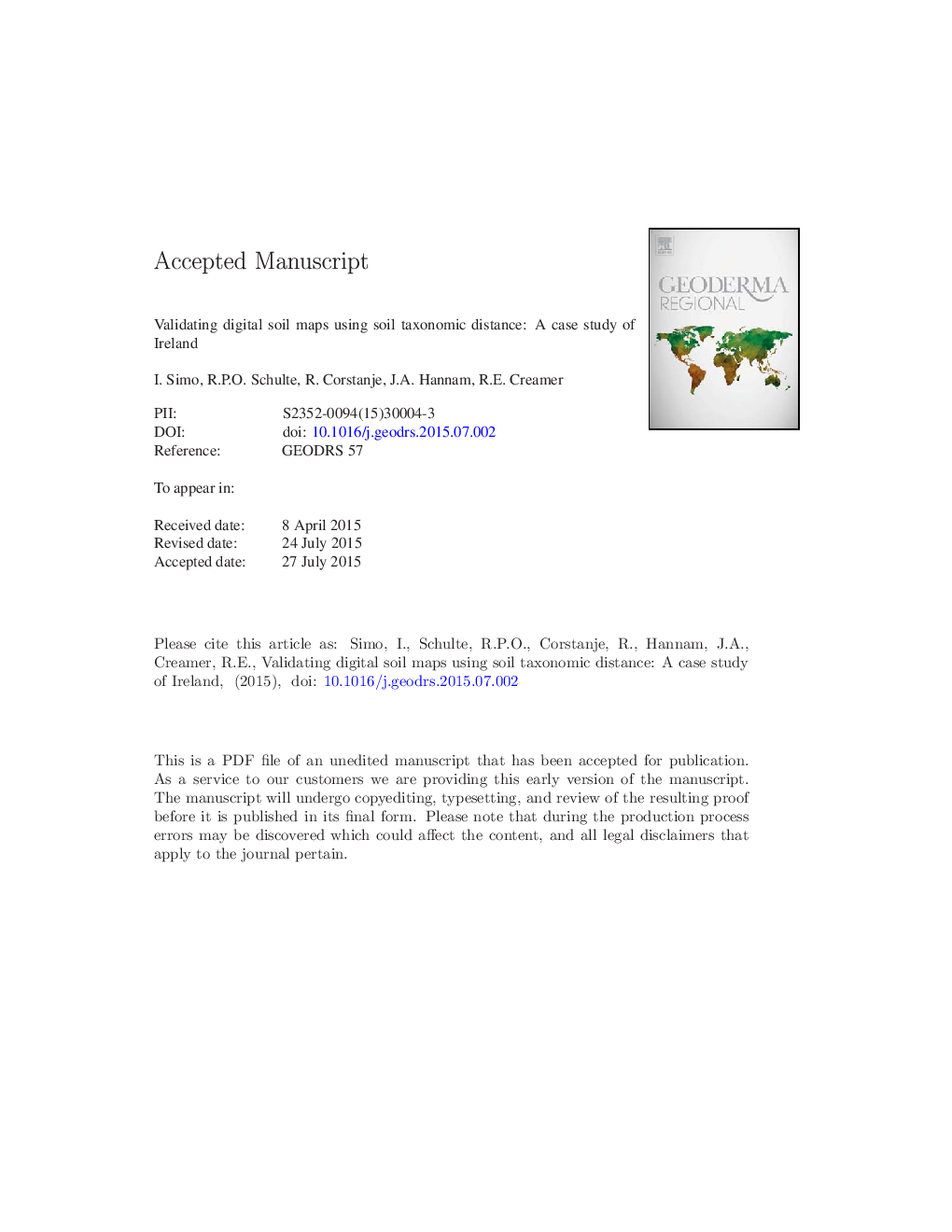| کد مقاله | کد نشریه | سال انتشار | مقاله انگلیسی | نسخه تمام متن |
|---|---|---|---|---|
| 6364140 | 1623010 | 2015 | 32 صفحه PDF | دانلود رایگان |
عنوان انگلیسی مقاله ISI
Validating digital soil maps using soil taxonomic distance: A case study of Ireland
ترجمه فارسی عنوان
اعتبار سنجی نقشه های خاک دیجیتال با استفاده از فاصله تاکسونومی خاک: مطالعه موردی ایرلند
دانلود مقاله + سفارش ترجمه
دانلود مقاله ISI انگلیسی
رایگان برای ایرانیان
کلمات کلیدی
ترجمه چکیده
اخیرا، افزایش تقاضا برای اطلاعات دیجیتالی خاک، که در آن تحقیق نقشه برداری خاک دیجیتال نقش کلیدی ایفا می کند، در سراسر جهان افزایش چشمگیری داشته است. روش های اعتباربخشی این نقشه های خاک دیجیتال مورد نیاز است. نقشه های خاک و در نقشه های تاکسونومی خاکی حاوی اطلاعات جاسازی شده است که نشان دهنده درک عمق خاک در چشم انداز و عوامل تشکیل دهنده آن است. این مقادیر را نمی توان به راحتی با یک مقایسه مستقیم به چند ضلعی اعتبار داد. علاوه بر این، عدم اطمینان در رابطه با طبقه بندی اشتباه، باینری نیست، بلکه یک معیار پیچیده تر است که به میزان واگرایی بین مشاهدات نقطه و واحد نقشه می پردازد که این روابط پایه ای بین خاک، چشم انداز و عملکرد را در نظر می گیرد. در اینجا ما یک رویکرد اعتبار سنجی نقشه بر اساس تنوع تاکسونومی خاک ارائه می دهیم و آن را با نتیجه ی اعتبار سنجی بر مبنای ارزیابی حضور / عدم حضور باینری مستقیم واحد نقشه ها مقایسه می کنیم. ما این کار را برای نقشه های تازه ای از خاک های ایرلند در مقیاس 1: 250،000 انجام می دهیم. ما دریافتیم که دقت کلی محاسبه شده از طریق روش عدم وجود حضور 69٪ دقیق است، در حالی که حداقل مفهوم فاصله تاکسونومی، دقت کلی 90.1٪ را دارد. به طور خاص، واحدهای نقشه خاک با پوشش فضایی وسیع، با استفاده از روش حضور / عدم حضور، به عنوان بسیار نامعینی ارزشیابی شدند، اعتماد به نفس در اطراف این واحدهای نقشه به طور معنی داری با استفاده از روش حداقل فاصله تاکسونومی بهبود یافت. در جایی که تفاوتهای زیادی بین مشاهدات میدانی و واحدهای نقشه برداری مشاهده شده مشاهده شد، ما اندازه گیری فاصله تاکسونومیکی را یک تشخیص اطلاعاتی تر نشان دادیم چرا که این تفاوت ها مشاهده شد.
موضوعات مرتبط
مهندسی و علوم پایه
علوم زمین و سیارات
فرآیندهای سطح زمین
چکیده انگلیسی
Recently, there has been a marked increase across the world in the demand for digital soil information, in which digital soil mapping research plays a key role. Methods to validate these digital soil maps are needed. Soil maps, and in particular soil taxonomic maps contain embedded information that represents an understanding of the functioning of the soil within its landscape and the contributing soil forming factors. These cannot be easily validated by a straight point-to-polygon comparison. Furthermore, the uncertainty associated with a misclassification is not binary, but rather a more complex measure that accounts for the degree of divergence between the point observation and map unit that takes into account these underlying relationships between soils, landscape and function. Here we present a map validation approach based on the soil taxonomic divergence and compare this to the outcome from validation based on a straight binary presence/absence evaluation of the map units. We do so for the newly generated soils map of Ireland at a scale of 1:250,000. We find that the overall accuracy calculated through the presence absence method was 69% accurate, whereas the minimum taxonomic distance concept, has an overall accuracy of 90.1%. In particular, soil map units with large spatial coverage tended to be assessed as being very uncertain using the presence/absence method, the confidence around these map units was significantly improved using the minimum taxonomic distance approach. Where large differences were observed between field observations and mapped soil units, we found the taxonomic distance measure a more informative diagnostic as why these differences were observed.
ناشر
Database: Elsevier - ScienceDirect (ساینس دایرکت)
Journal: Geoderma Regional - Volume 5, August 2015, Pages 188-197
Journal: Geoderma Regional - Volume 5, August 2015, Pages 188-197
نویسندگان
I. Simo, R.P.O. Schulte, R. Corstanje, J.A. Hannam, R.E. Creamer,
